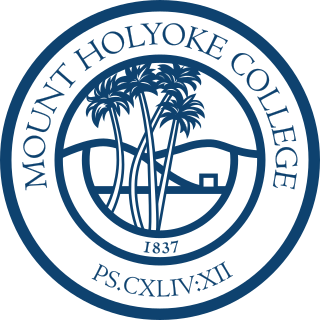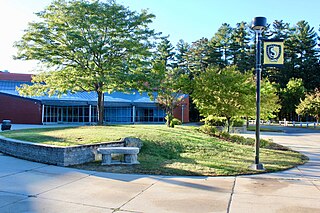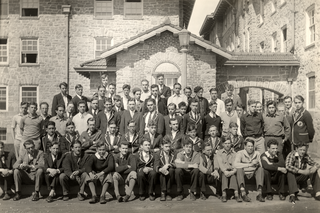Related Research Articles

Williams College is a private liberal arts college in Williamstown, Massachusetts. It was established as a men's college in 1793 with funds from the estate of Ephraim Williams, a colonist from the Province of Massachusetts Bay who was killed in the French and Indian War in 1755. It is the second-oldest institution of higher education in the Commonwealth of Massachusetts after Harvard College.

Amherst College is a private liberal arts college in Amherst, Massachusetts. Founded in 1821 as an attempt to relocate Williams College by its then-president Zephaniah Swift Moore, Amherst is the third oldest institution of higher education in Massachusetts. The institution was named after the town, which in turn had been named after Jeffery, Lord Amherst, Commander-in-Chief of British forces of North America during the French and Indian War. Originally established as a men's college, Amherst became coeducational in 1975.

Mount Holyoke College is a private liberal arts women's college in South Hadley, Massachusetts. It is the oldest member of the historic Seven Sisters colleges, a group of elite historically women's colleges in the Northeastern United States.

Hampshire College is a private liberal arts college in Amherst, Massachusetts. It was opened in 1970 as an experiment in alternative education, in association with four other colleges in the Pioneer Valley: Amherst College, Smith College, Mount Holyoke College, and the University of Massachusetts Amherst. Together they are known as the Five College Consortium. The campus also houses the National Yiddish Book Center and Eric Carle Museum, and hosts the annual Hampshire College Summer Studies in Mathematics.

Radcliffe College was a women's liberal arts college in Cambridge, Massachusetts, and functioned as the female coordinate institution for the all-male Harvard College. Considered founded in 1879, it was one of the Seven Sisters colleges and held the popular reputation of having a particularly intellectual, literary, and independent-minded female student body.

The Five College Consortium comprises four liberal arts colleges and one university in the Connecticut River Pioneer Valley of Western Massachusetts: Amherst College, Hampshire College, Mount Holyoke College, Smith College, and the University of Massachusetts Amherst, totaling approximately 38,000 students. They are geographically close to one another and are linked by frequent bus service which operates between the campuses during the school year.

The University of Massachusetts Amherst is a public research university in Amherst, Massachusetts and the sole public land-grant university in Commonwealth of Massachusetts. Founded in 1863 as an agricultural college, it is the flagship and the largest campus in the University of Massachusetts system, as well as the first established. It is also a member of the Five College Consortium, along with four other colleges in the Pioneer Valley: Amherst College, Smith College, Mount Holyoke College, and Hampshire College.

The University of Massachusetts is the five-campus public university system and the only public research system in the Commonwealth of Massachusetts. The university system includes five campuses, a satellite campus in Springfield and also 25 campuses throughout California and Washington with the University of Massachusetts Global.
John William Ward (1922–1985), was the 14th President of Amherst College, a veteran of World War II, Professor of English and History at Princeton University, and Chairman of the Ward Commission.

Wheaton College is a private liberal arts college in Norton, Massachusetts. Wheaton was founded in 1834 as a female seminary. The trustees officially changed the name of the Wheaton Female Seminary to Wheaton College in 1912 after receiving a college charter from the Commonwealth of Massachusetts. It remained one of the oldest institutions of higher education for women in the United States until men began to be admitted in 1988. It enrolls 1,669 undergraduate students with no graduate students.

Souhegan Cooperative High School is a Coalition of Essential Schools high school located in Amherst, New Hampshire, in the United States. Students from Amherst and Mont Vernon attend Souhegan for 9th through 12th grades. There are about 750 students. The school was founded based on the work of Theodore R. Sizer, a former dean of the Harvard Graduate School of Education, a notable American education reform leader and the father of the Essential Schools movement. Notably, Souhegan's progressive reputation has been chronicled in the book Standards of Mind and Heart: Creating the Good High School by Tony Wagner, Peggy Silvia and Dr. Robert A. Mackin. Based on this history, the school was founded with the mission "Souhegan High School aspires to be a community of learners born of respect, trust and courage." The school name is derived from its proximity to the Souhegan River, which adjoins the school property. The word Souhegan comes from the Algonquin language, meaning "waiting and watching place".

Massachusetts College of Pharmacy and Health Sciences (MCPHS) is a private university focused on medical and health-related science programs and located in Boston, Massachusetts. The university provides traditional and accelerated programs of study focused on professional education in pharmacy and the health sciences. Since 2000, MCPHS has expanded to include two additional campuses, located in Worcester, Massachusetts, and Manchester, New Hampshire.
Franklin Kessel Patterson was a professor and author, and the first president of Hampshire College in Amherst, Massachusetts. He was also, along with the other presidents of the Five Colleges, a co-author of the New College Plan.
Ramapo College of New Jersey is a public undergraduate liberal arts college founded in 1969.

Debraj Roy College is a leading public higher education institution established in 1949 at Jonaki Nagar in Golaghat. Affiliated to Dibrugarh University, the college has 15 departments running Higher Secondary and Undergraduate programmes both in Science and Arts. The college also offers Postgraduate and Doctoral Research programmes in Life Science in regular mode under Dibrugarh University. The college has a current enrollment of more than 2500 students. The college was ranked 4th among the colleges of Assam by Career360 in 2016.

The Apiary Laboratory, more often referred to as the Apiary, is a research laboratory at the University of Massachusetts Amherst. Originally built for the study of honey bees and apiculture, today it is primarily used to study native pollinator species and the chemicals and pathogens impacting their populations. This academic building is unique in that it is credited as being the first in the United States to be erected exclusively for the teaching of beekeeping.

The campus of the University of Massachusetts Amherst is located nearly entirely in Amherst, Massachusetts, United States, with a portion located in Hadley. Founded on 310 acres in rural Western Massachusetts, the campus has grown to nearly 1,450 acres.

The University of Wisconsin Experimental College was a two-year college designed and led by Alexander Meiklejohn inside the University of Wisconsin–Madison with a great books, liberal arts curriculum. It was established in 1927 and closed in 1932. Meiklejohn proposed the idea for an alternative college in a 1925 Century magazine article. The magazine's editor-in-chief, Glenn Frank, became the University of Wisconsin's president and invited Meiklejohn to begin the college within the university. Despite pushback from the faculty, the college opened in the fall of 1927 with a self-governing community of 119 students and less than a dozen faculty. Students followed a uniform curriculum: Periclean Athens for freshmen and modern America for sophomores. The program sought to teach democracy and to foster an intrinsic love of learning within its students.

Al-Quds University is a Palestinian university with campuses in Jerusalem, Abu Dis, al-Bireh, and Hebron.

Ramanujan College is a constituent college of University of Delhi. It is named after the Indian mathematician Srinivasa Ramanujan. It is located in Kalkaji, near Nehru Place in South Delhi. The college runs fifteen courses in the disciplines of Humanities, Commerce, Management, Mathematical Sciences, Computer Science and Vocational Studies. It is also the study center for the students of the Non- Collegiate Women's Education Board, University of Delhi and the Indira Gandhi National Open University. Ramanujan College has been accredited grade "A++" by the National Assessment and Accreditation Council (NAAC). Ramanujan College has also been selected by the MHRD as a Teaching Learning Center and National Resource Center.
References
- The New College Plan. The Committee for New College, 1958. The original Four College planning document that led to the founding of Hampshire College.
- Franklin Patterson and Charles R. Longsworth, The Making of a College, 1965
- Student Reactions to Study Facilities: with implications for architects and college administrators. The Committee for New College, 1960.
- More Power to Them: a report of faculty and student experience in the encouragement of student initiative. C.L. Barber; The Committee for New College, 1962.